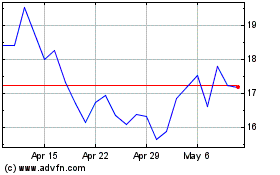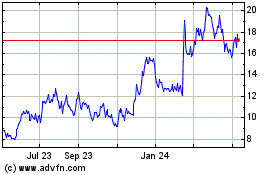Captive Insurance Seen as Covid-Era Remedy to Rising Premiums
September 27 2020 - 8:29AM
Dow Jones News
By Alice Uribe
Rising insurance premiums are costing businesses millions of
dollars they can ill afford as they navigate the coronavirus
pandemic. Many companies are responding by trying to manage risks
on their own.
A surge in demand for so-called captive insurance and the
increasing amount of capital being devoted to mitigating risks have
caught many in the industry by surprise, including brokers who sell
the idea of setting up a captive insurer.
A captive is owned and controlled by the business that
establishes it, which could be a restaurant, drugmaker or retailer.
It writes coverage for its owners and pays out claims when the
business runs into unexpected trouble. Before the coronavirus had
even appeared, some U.S. businesses had ensured their captives
wrote policies covering a potential pandemic, allowing them to
avoid disputes with mainstream insurers. Some mainstream insurers
have largely refused to pay out business-interruption claims made
by companies hurt by shutdowns.
Setting up one's own insurance company can be a risky strategy.
A captive insurer without sufficient capital -- particularly early
in its existence -- can become insolvent if it is hit with large
claims, leaving the parent company exposed at a time of need.
Captives also need to make underwriting and claims decisions at
arm's length from their owners. A failure to do so risks their
falling afoul of regulators in some countries.
But if a company can't find suitable cover on the open market,
setting up a captive could be an alternative. Going without
insurance might not be an option -- for regulatory reasons, a
company might need to show it has an insurance policy.
U.S.-based insurance broker Marsh said at least 25 of the
captives that it manages globally have been writing coverage for
pandemic risks. Many other businesses have set up captives to
counter premiums that have risen every quarter since late 2017. The
pandemic could fuel even higher premiums as insurers seek to price
risk more aggressively.
Marsh said the number of new captives it helped to form tripled
between January and July compared with a year earlier, coinciding
with a period when global insurance prices logged double-digit
increases in the midst of the coronavirus crisis. Aon, another
insurance broker, said it had also seen higher demand for the
units.
Investment group Blackstone Group Inc. is one company relying
more on captives as insurance premiums balloon.
In late July, its Gryphon Mutual Insurance Co. went live, the
culmination of months of preparatory work that began before the
pandemic. The captive is focused on property in North America, but
could be expanded to other regions in future.
"Ultimately, it will provide us with greater control over our
property insurance program and reduce premiums and brokerage costs
for our limited partners," a Blackstone spokesperson said.
Captives aren't a new tactic for companies to mitigate risk.
Credit-rating company A.M. Best Co. says the world's first captive
was formed in Bermuda in the 1960s in response to a hardening
insurance market, which describes when premiums get more expensive
and insurers' capacity for cover decreases. The use of captives
often coincides with a hardening insurance market, or during crises
such as the 9/11 terrorist attacks, or the hurricanes that ravaged
the Gulf of Mexico coast in 2004-05.
Many of the biggest U.S. companies have used captives, including
in the oil and gas sector. In recent years, ride-hailing companies
Uber Technologies Inc. and Lyft Inc. have formed insurance
subsidiaries. Insurance can be a challenge for companies engaging
in new business models: Mainstream insurers often don't have enough
information to price coverage in a way that would make these new
businesses economically viable.
Increased use of captives doesn't pose an immediate risk to the
insurance sector, brokers say. Aon said it reflects a reordering of
the industry, with insurers willing to give up business lines that
had become uneconomic. Still, companies with captives could look to
broaden their use in the future.
According to A.M. Best, the number of U.S. domestic captives
more than doubled to 3,133 between 2007 and 2019.
The pandemic has highlighted the attractiveness of being able to
tailor insurance using a captive, rather than relying on cover from
the open market through mainstream insurers. Many businesses
thought they were covered for unexpected shocks, only to be told by
their mainstream insurers that pandemic exclusions in the fine
print of policies made their claims invalid.
Around the world, courts are debating whether
business-interruption insurance policies held by millions of
companies cover a pandemic. In the U.S., property insurers have won
a flurry of judicial rulings backing up their rejections of claims
for businesses' lost income during government-ordered shutdowns,
dimming policyholders' hopes of payments to help them rebound. On
Sept. 15, a U.K. court ruled mostly in favor of policyholders in a
test case that examined different policy wordings.
Write to Alice Uribe at alice.uribe@wsj.com
(END) Dow Jones Newswires
September 27, 2020 08:14 ET (12:14 GMT)
Copyright (c) 2020 Dow Jones & Company, Inc.
Lyft (NASDAQ:LYFT)
Historical Stock Chart
From Mar 2024 to Apr 2024

Lyft (NASDAQ:LYFT)
Historical Stock Chart
From Apr 2023 to Apr 2024
